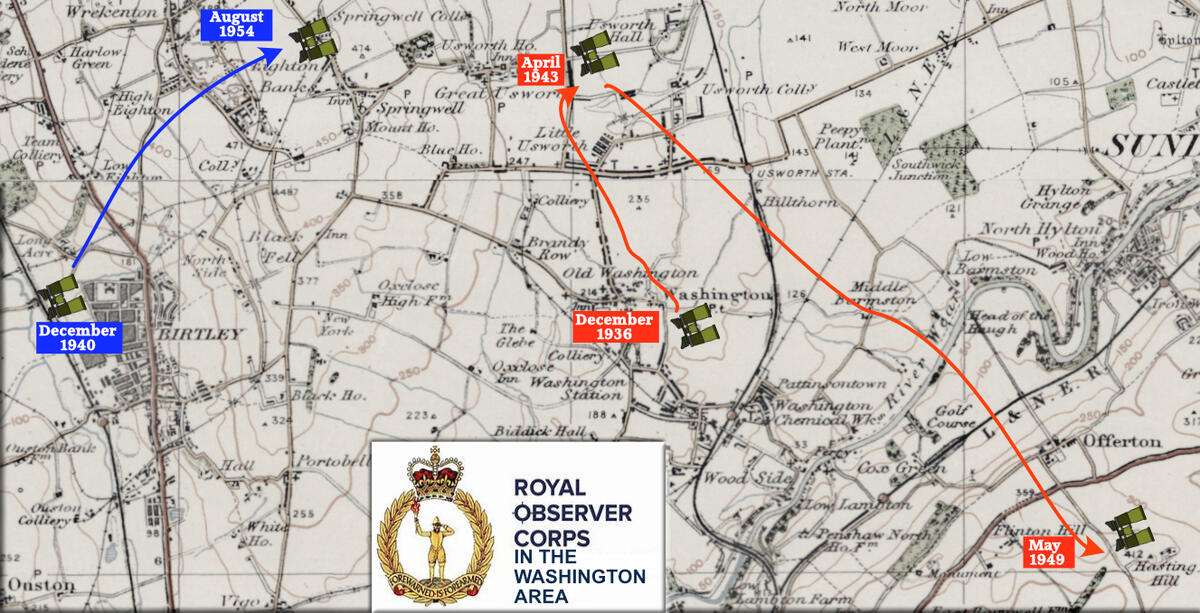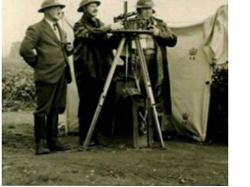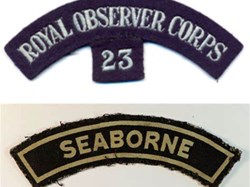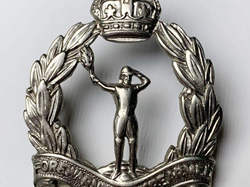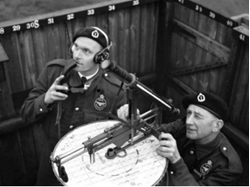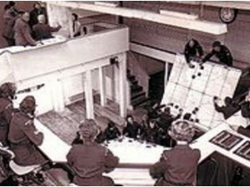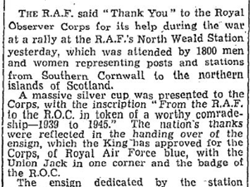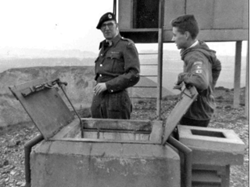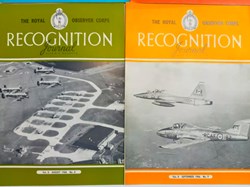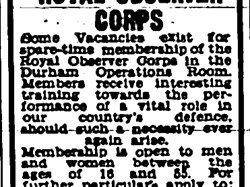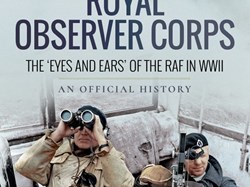Washington ROC Posts
Royal Observer Corps Posts in Washington and Springwell
The Royal Observer Corps (ROC) was a civil defence organisation set up for the detection, identification tracking and reporting of aircraft over Great Britain. It succeeded the Metropolitan Observation Service, that had covered the London Air Defence Area out to the Kent and Essex coasts during World War One.
The Corp operated between 29 October 1925 and 31 December 1995 when it was stood down. The organisation was composed of part-time civilian volunteers. Members were issued with RAF style uniforms and initially came under the administrative control of RAF Strike Command and the operational control of the Home Office. Volunteers were trained and administered by professional officers.
Inter-War Years
The system started in south east England, and by the outbreak of World War Two in 1939 almost full coverage of Great Britain was achieved, including a post located by Glebe Crescent in Washington Village in 1936- see the map below.
The system required the cooperation of the RAF, the Army, the Police, and the General Post Office (for communications). In 1926 the Police recruited observers as Special Constables. Each observation post was manned by a sergeant and six constables. Recruits were unpaid. and their only identification was an Observer Corps lapel badge, purchased at their own expense!
At this time the only uniform issued to personnel were steel helmets bearing the letters “OC” together with blue/white vertically striped armbands bearing the same letters.
Posts were very basic and could be set up on any piece of land with good views of the sky, and with proximity to a telephone pole so that phone messages could be passed to a control centre. A canvas wind break was provided though later in the war more substantial posts were erected of brick, but there was no standard designs.
Post equipment consisted of the theodolite-like instrument mounted on a tripod, which would plot the location, height and direction of travel of the target. High quality Royal Navy issue binoculars were issued to help with identification of aircraft. The information would then be passed by telephone to RAF control centres.
In 1929 control of the Observer Corps passed to the Air Ministry, although the Police retained responsibility for recruitment.
The Second World War
On 24 August 1939 Mobilisation Notices were issued to all Observer Corps members and war was declared ten days afterwards. From 3 September 1939 observation posts and control centres would be manned continuously until 12 May 1945, four days after VE Day.
During the Battle of Britain period, from July to October 1940, the Observer Corps was at full stretch, operating 24 Hours a day, 7 days a week, plotting enemy aircraft and passing information to the RAF. Enemy aircraft could be detected approaching the coast of Great Britain by an early radar system known as “Chain Home”, but once a raid moved inland the only means of identification and plotting was through Observer Corps posts. The battle was eventually won by Fighter Command and as result of their contribution to the victory the Observer Corps was given the title “Royal” by King George VI.
The ROC became a uniformed civil defence organisation administered by RAF Fighter Command. At this time women were recruited for the first time.
With the advent of the V1 flying bomb the ROC again provided an invaluable service by tracking their flight path for RAF aircraft interception.
One of the lesser known tasks of observers was to serve aboard Royal Navy and United States Navy ships during the Invasion of France, in order to reduce the incidences of friendly fire. 796 volunteers were given the rank of Petty Officer and control of the ships’ anti-aircraft batteries. Two seaborne observers lost their lives during the invasion and ten were mentioned in despatches. In recognition of their success King George VI approved the wearing of “SEABORNE” flashes on the shoulders of individuals who had taken part.
In May 1945 when it became clear that the Luftwaffe had ceased combat operations the ROC was stood down. In recognition of the contribution made by the ROC to the Allied victory a massed air display was organised from the 23 to 25 June 1945 at RAF North Weald Essex. with a uniformed march-past of over 1,800 observers, accompanied by the RAF band. The ROC Ensign was then presented by Lord Beatty, Under-Secretary for Air.
It would only be a few months before the ROC would be again called upon to meet the challenges of the Cold War.
Local Posts
Washington History Society is interested to discover where Observer Corps post existed in the Washington area during and after WW2. The Royal Observer Corps Association gave map references for the Glebe Crescent post referred to above, that has been confirmed by the discovery of a WW2 Home Guard map of Washington now in Durham Archives. This post was moved to Usworth Colliery in 1943.
Moving the site would not have been difficult, as at this stage in the war, posts were still very basic, little more than a wooden shed or a circle of sandbags, with a couple of folding chairs! Unfortunately, we have not been able to find any further information about the post or the observers on duty, and no photographs have come to light.
The ROC continued to operate post-war, but activities were restricted to weekend training meetings and exercises. Annual week-long camps were held at RAF stations to introduce new equipment and procedures.
The post at Usworth Colliery was relocated to Hastings Hill, Sunderland- see the map below. It closed in 1959 when an underground nuclear bunker was constructed on the site.
Another post, that had been placed next to the main rail line at Birtley in 1940, was relocated to Springwell Colliery, the highest point in the Washington area.
Aircraft recognition was still given high priority in the jet age. Tom Hollins, of the prefabs at Usworth Green, was a member of the Springwell post in the 1950s His son, Brian, remembers testing his Dad with flash cards of aircraft silhouettes, and his attendance at film training sessions where observers had to identify moving aircraft.
Members also had regular issues of the ROC Recognition Journal which contained aircraft recognition photo tests. The only other part-time member of the Washington post that we have been able to identify was Harry Green, the Head Teacher of Usworth Secondary School
At the Springwell site a prefabricated concrete observation post, known as an Orlit B, was erected in 1954. This had a removable corrugated-iron roof which could be removed to allow aircraft reporting. It also offered a covered section to give some shelter. This above-ground post was still in existence when an underground nuclear reporting bunker was built beside it in 1959, with the code name November 4, and survived until 1969.
The operations of this bunker in the 1960s are explained in the accompanying article -Springwell ROC Bunker
When he was 18, Society member, Ernie Guy, replied to an advert in a local newspaper asking for volunteers to join the Royal Observer Corps. He was a member from 1960 to 1969, though more on alert for nuclear fallout rather than aircraft recognition. It was aircraft from RAF Usworth, just a mile east of his home in the Usworth Green prefabs, that sparked his lifelong interest, reinforced by old copies of the ROC Recognition Journal, given to him by his friend Brian Hollins, whose father Tom Hollins was a member of the Royal Observer Corps.
If readers have any further details, memories or photographs of these site please contact us by email: wasgingtonhistorysoc@gmail.com
(Sources: Personal images of author, Ernie Guy, various Wikipedia articles, The Royal Observer Corps Association, British Newspaper Archive, ebay images)
